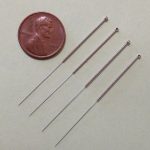
A recent review (Dental Elf – 3rd Feb 2021) estimated the prevalence of temporomandibular disorders (TMD) to be 29.3% (95%CI: 6.1–72.3%) although the confidence intervals are very wide. Typical TMD are treated conservatively with interventions including physical therapy (ultrasound, ultrashort wave, laser, heat, electro-stimulation, relaxation exercises, active exercises, stretching, and biofeedback); use of a splint or brace; and pharmacological therapy. Surgical approaches such as arthrocentesis or arthroscopy may be used when these approaches are ineffective, and a number of studies have shown that acupuncture for TMD have shown high levels of patient satisfaction.
The aim of this review was to assess the effectiveness and safety of acupuncture in treating temporomandibular joint disorders (TMD).
Methods
A protocol was registered with the PROSPERO database. Searches were conducted in the Medline, Embase, Cochrane CENTRAL, China National Knowledge Infrastructure, Japanese citation Information by NII, Korea Med, Korean Medical Database; Oriental Medicine Advanced Searching Integrated System; National Discovery for Science Leaders; and Korean Studies Information Service System. Randomised controlled trials (RCTs) using acupuncture as an intervention for TMD in adults were included. Interventions considered included acupuncture, electroacupuncture, dry needling (DN), warm-needle acupuncture, traditional acupuncture (KM acupuncture points), and contemporary acupuncture (A-shi points and trigger points). Non-treatment and sham acupuncture were considered inactive controls while active controls included physical therapies, injection therapy, splinting, and drug therapy including analgesia. Studies that did not use an objective assessment tool or those whose reliability and validity had not been established were excluded. Two reviewers independently selected studies extracted data and assessed risk of bias using the Cochrane tool (RoB2). Continuous variables were assessed using mean difference (MD) or standardised MD (SMD) with 95% confidence intervals (CI) and dichotomous variables as relative risk (RR) with 95%CI.The certainty of evidence was assessed using the grading of recommendations, assessment, development and evaluation (GRADE) approach.
Results
- 32 RCTs met the inclusion criteria.
- 9 studies were from China, 5 from Brazil, 4 from Spain, 3 each from Turkey and the USA, 2 each from Austria, Sweden and the UK, and one each from Japan and Poland.
- None of the included studies were at low risk of bias, 2 were at high risk with all other studies demonstrating some concerns.
- Sample sizes ranged from 12-240 patients.
- 22 studies contributed to the meta-analysis.
Acupuncture versus inactive control.
- Meta-analysis (9 RCTs, 283 patients) showed TMD pain assessed using VAS was improved significantly with acupuncture, SMD = 0.49 (95% CI: 0.24 to 0.73).
- Meta-analysis (5 RCTs, 152 patients) indicated that acupuncture significantly improved maximum mouth opening (MMO) compared to inactive control, MD = 4.18 (95%CI: 2.87 to 5.48).
- Only 1 small study involving 30 patients assessed the effect rate of acupuncture in TMD treatment suggesting a benefit from acupuncture, RR = 7.00 (95%CI: 1.91 to 25.62).
Acupuncture versus active control treatment
- Meta-analysis (3 RCTs,133 patients) found no difference between acupuncture and active treatments, MD = −0.41(95%CI: −0.91 to 0.10).
- Only 1 study (40 patients) assessed MMO finding no significant difference between acupuncture and active control groups, MD = 1.05 (95%CI: −2.36 to 4.46).
- Meta-analysis (9 RCTs,746 patients) showed that acupuncture significantly affected the effect rate, RR = 1.19(95%CI: 1.12 to 1.27).
- The GRADE certainty of the evidence was rated as very low to low.
Conclusions
The authors concluded: –
it was difficult to reach a definitive conclusion regarding the effectiveness of acupuncture in TMD treatment because the studies included in the analysis were determined to contain low-quality data. Therefore, well-designed, large-scale RCTs are warranted in the future.
Comments
The authors preregistered this review in the PROSPERO database although their original title was broader and looking to consider the use of Korean medical treatments for TMD including herbal medicine, acupuncture, chuna, pharmacopuncture etc. The published review focuses only on acupuncture. A broad database search was undertaken involving 11 databases with 32 RCTs finally meeting the inclusion criteria. We have previously looked at a review of acupuncture for TMD (Dental Elf – 28th Jun 2011) which included 7 RCTs. Analysis was conducted for acupuncture versus inactive controls (16 RCTs) and acupuncture versus active controls (19 RCTs) with some studies including both active and inactive controls. The included studies were very heterogeneous owing to various types of acupuncture use and variation in the type of control used there also difficulties in relation to blinding. While the findings indicated a benefit from acupuncture the quality of the studies was limited so the certainty of the evidence was rated as very low to low. Consequently the findings should be interpreted cautiously and future studies should be well designed and reported and of appropriate size.
Links
Primary Paper
Park EY, Cho JH, Lee SH, Kim KW, Ha IH, Lee YJ. Is acupuncture an effective treatment for temporomandibular disorder?: A systematic review and meta-analysis of randomized controlled trials. Medicine (Baltimore). 2023 Sep 22;102(38):e34950. doi: 10.1097/MD.0000000000034950. PMID: 37746950; PMCID: PMC10519525.
Other references
Dental Elf – 3rd Feb 2021
Dental Elf – 28th Jun 2011
Limited evidence for acupuncture as a symptomatic treatment of TMD
Dental Elf – Temporomandibular Joint Disorder Blogs
Picture Credits
By Acuhealth – Own work, CC BY-SA 3.0
